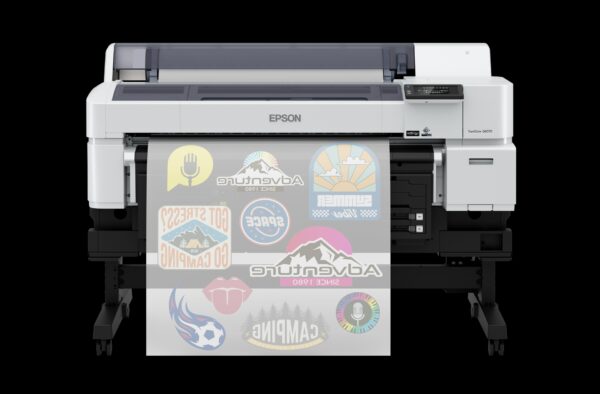Can cut-sheet inkjet technology save print clicks?
What is inkjet’s status heading into the second half of 2022? Most inquiring dealers realize the answer to that question depends on who they ask and, of course, what is being printed.
“HP has exited single-pass office inkjet,” pointed out Marco Boer, vice president of IT Strategies, the Boston-based consultancy that serves digital print vendors. “Xerox exited several years ago with its old, solid inkjet technology. Canon has played with entering but never did because, frankly, it is not in their economic interest as toner is more profitable, especially for their dealer channel.”
Conversely, Epson America holds major inkjet ambitions and is making progress, according to Joe Contreras, commercial marketing executive for office solutions. “Epson is still bullish on the inkjet market,” he said. “We had a phenomenal year in 2021, meeting our business plan’s North American budget, which was a huge accomplishment under the circumstances we faced [from COVID-19].”
Andre D’Urbano, sales and marketing executive director for RISO, looks to the production print space for guidance. “Cut-sheet inkjet is painting a path,” he said. “It’s immensely popular at the production level and is a hot market.”
In April, D’Urbano traveled to Austin, Texas, for the three-day Inkjet Summit presented by NAPCO Media, which enjoyed a record number of end-user attendees. “The ‘tire-kickers’ are turning into buyers as more people continue the transition away from offset presses,” he said. For RISO, whose fiscal year ended March 31, the positive trend toward cut-sheet inkjet led to being over quota in 2021.
Budgetary Contractions and Open Minds
According to D’Urbano, RISO’s device sales last year were 120% of target—well beyond where the company thought they would be. He attributes the reopening of schools to some of the financial gains. “Budgets have constricted post-COVID, and the belt-tightening extends to the office as well,” he said. “Inkjet printing’s lower price messaging is being well received.”
The move to a more hybrid workforce led to a 60% shortfall in office printing, according to D’Urbano. If employees are in the office three out of five days during the week, how can dealers make up for the volume loss? Many are now selling managed print services, IT security services, and software to fill the void. Another way could be by venturing into the production arena.
“Inkjet images may look flat, but it’s sellable,” acknowledged D’Urbano. “When dealer reps walk into production shops and in-plants saying, we’re here for inkjet, people’s ears perk up. It won’t look the same, but it’s half the price.”
Most cut-sheet, color-inkjet devices crank out between 60 and 100 impressions per hour (iph). RISO’s best-selling ComColor GD 9630 model is faster, outputting 160 iph at a price point in the $100,000 range.
Mega-dealer Pacific Office Automation (POA), which began partnering with RISO in early 2021, ended the year among the Top 5 U.S. performers. POA has 27 West Coast offices and annual sales approaching $400 million. The new client was a quick study right out of the gate, D’Urbano reported, and the dealership’s approach is not complicated.
POA president and CEO Doug Pitassi emphasizes open-mindedness and the numbers game to his salespeople, and he also instills them with a simple message: If someone says that color printing is too expensive, they are a prospect for inkjet. One creative rep sold a RISO device to a roller skating rink, which now prints its flyers, promotions, tickets, and coupons, in color, at a fraction of the cost it had been paying to outsource these jobs.
D’Urbano cited approximate industry prices at 12 cents per page for color toner and 5 cents for inkjet (compared to 3 cents per page for black-and-white toner). The clicks add up to savings—some $7,000 on a run of 100,000 pages—for color, which is good enough for most applications.
“On non-color-critical jobs, inkjet’s quality is acceptable,” he added. In printer parlance, that’s called pleasing to the eye. In many cases, such as billing statements, color is only used to highlight.
Last August, RISO rolled out its high-speed VALEZUS T2100 duplexing, cut-sheet inkjet device, which is twice as fast as the ComColor GD 9630. The VALEZUS reproduces up to 320 color impressions per minute with full variable-data print capability. It’s also twice the price of the ComColor GD 9630. “We’ve picked up steam in this product category,” reported D’Urbano. Twelve of the $220,000 printers have been sold to date, mostly for transactional applications.
The speedy machines are a good fit for government in-plant print shops such as transportation and utility departments. “We enable them to print low-cost statements with highlights in color,” said D’Urbano.
Also bolstering RISO’s inkjet printer sales over the past 12 months are new, national relationships with toner device manufacturers Canon Solutions America (CSA) and Toshiba America Business Solutions (TABS). “Becoming our authorized, third-party vendors helps these OEMs to get their feet in the doors of customers below the $1-million level such as smaller school districts,” said D’Urbano. “It’s a strategic play for CSA and TABS, which together have nearly 1,000 reps in the field. For RISO, these partnerships help spread the word about inkjet technology, which could aid dealerships in the long run.
Grabbing Market Share
Epson dealers, too, have experienced success in the color inkjet production print niche. And handling the printing for vertical markets in education, health care, and medium- to small-sized customers often leads to incremental business.
Epson’s Contreras knows the numbers don’t lie. He reported that unit sales for Epson’s A3 WorkForce Enterprise series of printers grew by three times in 2021. The original equipment manufacturer’s healthy inventory availability enabled it to pick up market share from OEMs that did not have products to fulfill 90- to 120-day cycles.
“We doubled our number of active dealers who buy consistently on a month-by-month basis,” said Contreras, adding that careful planning and close communication with the factory and partners was crucial. The A4 arena proved more challenging as demand soared during the pandemic. “We still grew [A4] significantly but are playing catch-up to keep up,” he added.
The research lab is what may differentiate printer offerings. “Not all inkjet is created equal,” observed Contreras, who will pit his firm’s PrecisionCore technology against laser technology any time. Epson’s engineers designed a print chip to deliver increased speed and superior image quality, generating up to 40 million precise dots per second while yielding precise ink placement and fewer distortions/imperfections. “Our technical message is resonating,” he added, as Epson seeks additional dealer partners in some of its under-represented regions in the northeastern, southern, and western United States.
Less Energy, More Uptime
Sustainability is another benefit of Epson inkjet. Fewer moving parts and components allow these inkjet devices to consume 75% less energy, which means much less waste, according to Contreras.
In addition to the green angle, reliability and a better service experience also are part of the value proposition. “Epson inkjet devices can run up to three and a half times longer than [many] competing laser devices before modifications from technicians are required, so there’s much less break and fix,” said Contreras.
Dispatching fewer technicians can represent a mind shift for some dealers. “They need to realize that they’re still selling service,” noted Contreras. “The key is to boost profitability on service when intervention is needed. The real savings come from labor because any given tech can service a larger number of devices in the field, which translates to ownership demanding a better margin.”
Since late 2021, Epson has worked with NEXERA (a BEI Services company) to collect third-party service histories at customer installations. But don’t take Contreras’ word about making inkjet work for your dealership. He emphasized talking to other dealers who’ve got their heads around this concept and who’ve done it.
Access Related Content





